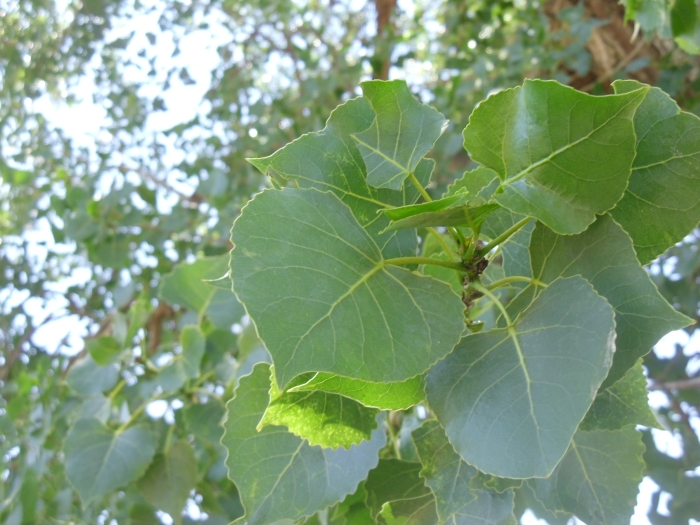Plains Cottonwood
(Populus deltoides subsp. monilifera)
Plains Cottonwood (Populus deltoides subsp. monilifera)
/
/

Eric Watts
CC BY 4.0
Image By:
Eric Watts
Recorded By:
Copyright:
CC BY 4.0
Copyright Notice:
Photo by: Eric Watts | License Type: CC BY 4.0 | License URL: http://creativecommons.org/licenses/by/4.0/ | Rights Holder: Eric Watts | Publisher: iNaturalist | Date Created: 2012-12-29T22:22:52-08:00 |

















Estimated Native Range
Summary
Populus deltoides subsp. monilifera, commonly known as Plains Cottonwood, is a deciduous tree native to riverbanks, floodplains, and wetlands in the Central USA, particularly along the Missouri and Mississippi Rivers. It can grow rapidly to a height of 30-100 feet (9-30 meters) and a width of 30-50 feet (9-15 meters), with a broad, open crown and stout branches. The bark is deeply furrowed, and the tree is known for its large, triangular leaves that flutter in the wind, creating a distinctive rustling sound. The flowers are not showy, but the tree produces cotton-like seeds that can be a nuisance in urban areas. Flowering occurs in early spring before the leaves emerge.
Plains Cottonwood is valued for its rapid growth and ability to thrive in wet conditions, making it suitable for erosion control and riparian plantings. It is also used for windbreaks and as a shade tree in large spaces. However, its extensive root system can be problematic near structures or pavement. This species requires full sun and ample water, preferring soils with fast drainage. It is tolerant of a range of soil types, including clay, loam, and sand, as long as they are moist. Plains Cottonwood is susceptible to diseases such as cankers and leaf rust, and pests like the cottonwood borer can cause damage to the tree.CC BY-SA 4.0
Plains Cottonwood is valued for its rapid growth and ability to thrive in wet conditions, making it suitable for erosion control and riparian plantings. It is also used for windbreaks and as a shade tree in large spaces. However, its extensive root system can be problematic near structures or pavement. This species requires full sun and ample water, preferring soils with fast drainage. It is tolerant of a range of soil types, including clay, loam, and sand, as long as they are moist. Plains Cottonwood is susceptible to diseases such as cankers and leaf rust, and pests like the cottonwood borer can cause damage to the tree.CC BY-SA 4.0
Plant Description
- Plant Type: Tree
- Height: 30-100 feet
- Width: 25-40 feet
- Growth Rate: Rapid
- Flower Color: N/A
- Flowering Season: Spring
- Leaf Retention: Deciduous
Growth Requirements
- Sun: Full Sun
- Water: High
- Drainage: Fast
Common Uses
Bee Garden, Bird Garden, Butterfly Garden, Drought Tolerant, Fire Resistant, Fragrant, Water Garden
Natural Habitat
Riverbanks, floodplains, and wetlands in the Central USA
Other Names
Common Names: Plains Poplar , Western Cottonwood , Peuplier De Virginie , Peuplier Deltoïde De L’Ouest , Eastern Cottonwood
Scientific Names: Populus deltoides subsp. monilifera , Populus deltoides var. monilifera , Populus sargentii , Populus deltoides var. occidentalis , Populus monilifera , Populus besseyana , Populus occidentalis , Populus virginiana , Populus sargentii var. texana , Populus marylandica
GBIF Accepted Name: Populus deltoides subsp. monilifera (Aiton) Eckenw.